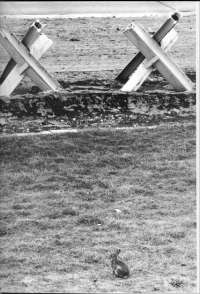Andreas Gedin: Plan for Berlin: ”A Walk in Paradise”, 1997
This project concerned the specific conditions for the fauna in the No mans land (or what is left of it) surrounding the former Berlin wall. It was neither a city park or a forest. What interested me were all the rabbits who was living an isolated extremely good life there with almost no threats from other animals. In the same time this paradise was poisoned by humans (East German authorities) to prevent the vegetation to grow. This was done so that no refugees would be able to hide behind any bushes.
The area deserted by humans was innocent in a way. But the watching, the supervising, and the poisoning was of both a godlike and perverted kind. In this huge, divided city was the least used space the most watched. The irony is that two foxes by hazard came in to this area and found food –rabbits– everywhere. But it is also an irony that both the rabbits and the foxes, were poisoned by what they ate.
The No mans land was a total artificial area also related to what is ”natural” for a modern city or country. It was a ”poisoned wilderness”, and the ”natural city” was taking over again, like the jungle taking over a rarely used path.
The starting point of my project was, besides the fact that the area is vanishing, these dichotomies:
1. fox/rabbit.
2. artificial /natural.
3. paradisical, free, objects of voyeurs/poisoned, supervised space, voyeurism, Gods eye.
4. country, periphery/city, centre.
My plan was to start this project with a walk along the border, or what was left of it. The distance is about 180 km and it should be possible to make it in four days. My plan was to stay in hotels close to the stops. The excursion would have been planned in detail in advance: where to stay, what to bring, the duration of every days walk etc. The first task was to look for rabbits but I imagined that the walk also would have provided me with a lot of material for my work and would in itself have been a part of the project. It would also have involved something that interests me, that is my situation as a foreigner and traveller. The walk would be a way for me to control Berlin, a quite unknown area. And this controlled situation is both related to the Wall and to the situation of the rabbits. I also planned to take contact with experts in different fields like experts in poisons, botanists, supervising specialists, biologist etc. This unrealized idea was exposed in a project called "The Museum of Homeless Ideas" in Zagreb 2002. I was later called by a Polish filmmaker who parallel to my plans had been working on a documentary based on the rabbits in the death zone of the Berlin Wall. And I now find out that the documentary ”Rabbit à la Berlin” released 2009.
Andreas Gedin: Plan for Berlin: ”A Walk in Paradise”, 1997
This project concerned the specific conditions for the fauna in the No mans land (or what is left of it) surrounding the former Berlin wall. It was neither a city park or a forest. What interested me were all the rabbits who was living an isolated extremely good life there with almost no threats from other animals. In the same time this paradise was poisoned by humans (East German authorities) to prevent the vegetation to grow. This was done so that no refugees would be able to hide behind any bushes.
The area deserted by humans was innocent in a way. But the watching, the supervising, and the poisoning was of both a godlike and perverted kind. In this huge, divided city was the least used space the most watched. The irony is that two foxes by hazard came in to this area and found food –rabbits– everywhere. But it is also an irony that both the rabbits and the foxes, were poisoned by what they ate.
The No mans land was a total artificial area also related to what is ”natural” for a modern city or country. It was a ”poisoned wilderness”, and the ”natural city” was taking over again, like the jungle taking over a rarely used path.
The starting point of my project was, besides the fact that the area is vanishing, these dichotomies:
1. fox/rabbit.
2. artificial /natural.
3. paradisical, free, objects of voyeurs/poisoned, supervised space, voyeurism, Gods eye.
4. country, periphery/city, centre.
My plan was to start this project with a walk along the border, or what was left of it. The distance is about 180 km and it should be possible to make it in four days. My plan was to stay in hotels close to the stops. The excursion would have been planned in detail in advance: where to stay, what to bring, the duration of every days walk etc. The first task was to look for rabbits but I imagined that the walk also would have provided me with a lot of material for my work and would in itself have been a part of the project. It would also have involved something that interests me, that is my situation as a foreigner and traveller. The walk would be a way for me to control Berlin, a quite unknown area. And this controlled situation is both related to the Wall and to the situation of the rabbits. I also planned to take contact with experts in different fields like experts in poisons, botanists, supervising specialists, biologist etc. This unrealized idea was exposed in a project called "The Museum of Homeless Ideas" in Zagreb 2002. I was later called by a Polish filmmaker who parallel to my plans had been working on a documentary based on the rabbits in the death zone of the Berlin Wall. And I now find out that the documentary ”Rabbit à la Berlin” released 2009.

